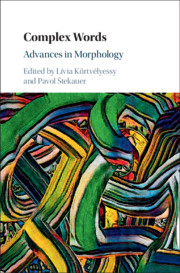Book contents
- Complex Words
- Complex Words
- Copyright page
- Dedication
- Contents
- Contributors
- Introduction: Advances in Morphology
- Part I Lexico-Semantic Aspects of Complex Words
- Part II Structure of Complex Words
- Part III Corpus-Based Case Studies
- 13 Competition between Synthetic NN Compounds and NN.gen Phrasal Nouns in Polish
- 14 An S Is an ’S, or Is It? Plural and Genitive Plural Are Not Homophonous
- 15 The Role of Word-Formation Families and Subfamilies in the Organization of German Diminutive Compounds
- 16 Semantic Patterns in Noun-to-Verb Conversion in English
- 17 Onomatopoeia
- 18 Dingsbums and Thingy
- Index
- References
14 - An S Is an ’S, or Is It? Plural and Genitive Plural Are Not Homophonous
from Part III - Corpus-Based Case Studies
Published online by Cambridge University Press: 18 September 2020
- Complex Words
- Complex Words
- Copyright page
- Dedication
- Contents
- Contributors
- Introduction: Advances in Morphology
- Part I Lexico-Semantic Aspects of Complex Words
- Part II Structure of Complex Words
- Part III Corpus-Based Case Studies
- 13 Competition between Synthetic NN Compounds and NN.gen Phrasal Nouns in Polish
- 14 An S Is an ’S, or Is It? Plural and Genitive Plural Are Not Homophonous
- 15 The Role of Word-Formation Families and Subfamilies in the Organization of German Diminutive Compounds
- 16 Semantic Patterns in Noun-to-Verb Conversion in English
- 17 Onomatopoeia
- 18 Dingsbums and Thingy
- Index
- References
Summary
Recent research on the acoustic properties of S-final words in English has revealed unexpected effects of morphology on phonetic realization, especially on acoustic duration (Zimmermann 2016, Plag et al. 2017, Seyfarth et al. 2017, Tomaschek et al. 2019). In this paper, we investigate 462 plural tokens and 417 genitive-plural tokens elicited in a production experiment. The statistical analyses show that plural S is significantly shorter than genitive-plural S. The duration effect is, however, not restricted to the final S, but extends over the whole word. We find that word-form frequency is predictive of duration, resulting in shorter durations for (the more frequent) plurals, and longer durations for (the less frequent) genitive plurals.The empirical findings also have implications for morphological theory. Word-form frequency effects for regularly inflected words in speech production are at odds with theories in which only morphologically irregular words, or highly frequent regular words, are assumed to be stored (e.g. Pinker 1999, Alegre & Gordon 1999). The word-form frequency effect can be more naturally accounted for in word-and-paradigm models of morphology (e.g. Matthews 1974, Blevins 2016), in which individual word-forms may have representations in a network of morphologically related forms.
- Type
- Chapter
- Information
- Complex WordsAdvances in Morphology, pp. 260 - 292Publisher: Cambridge University PressPrint publication year: 2020

